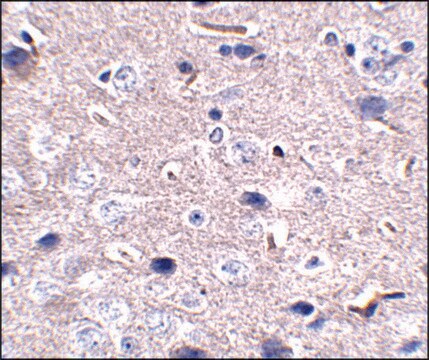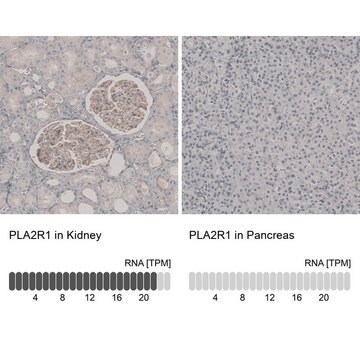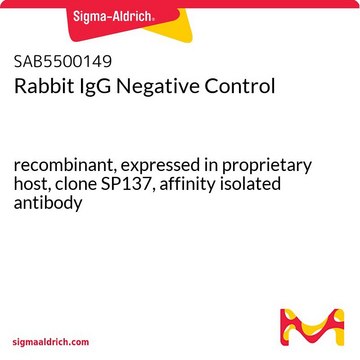MABF925
Anti-FcγRII (human) Antibody, clone AT10
clone AT10, from mouse
Sinônimo(s):
CD32CDw32, Fc-gamma RII-a, Fc-gamma RII-b, Fc-gamma RII-c, Fc-gamma-RIIa, Fc-gamma-RIIb, Fc-gamma-RIIc, FcRII-a, FcRII-b, FcRII-c, IgG Fc receptor II-a, IgG Fc receptor II-b, IgG Fc receptor II-c, Low affinity immunoglobulin gamma Fc region receptor II-a
About This Item
Produtos recomendados
fonte biológica
mouse
Nível de qualidade
forma do anticorpo
purified immunoglobulin
tipo de produto de anticorpo
primary antibodies
clone
AT10, monoclonal
reatividade de espécies
human
técnica(s)
flow cytometry: suitable
Isotipo
IgG1κ
nº de adesão NCBI
Condições de expedição
dry ice
modificação pós-traducional do alvo
unmodified
Informações sobre genes
human ... FCGR2A(2212) , FCGR2B(2213)
Descrição geral
Especificidade
Imunogênio
Aplicação
Flow Cytometry Analysis: A representative lot was conjugated with Phycoerythrin (PE) and immunostained the surface of human Burkitt′s lymphoma Ramos cells transfected with FcγRIIB, but not untransfected Ramos cells (Courtesy of Professor Martin J. Glennie, University of Southampton, UK).
Flow Cytometry Analysis: Clone AT10 hybridoma culture supernatant was employed to detect FcγRII-positive peripheral blood lymphocytes (PBLs) by flow cytometry (Greenman, J., et al. (1991). Mol. Immunol. 28(11):1243-1254).
Immunoprecipitation Analysis: A representative lot immunoprecipitated FcγRII from human K562 erythroleukemic cells (Greenman, J., et al. (1991). Mol. Immunol. 28(11):1243-1254).
Affinity Binding Assay: Affinity binding study using the Fab′ fragment of clone AT10 showed an equilibrium binding constant (Ka) of 5.3 x 10^8/M and a total of 1.5 x 10^5 binding sites per K562 cell (Greenman, J., et al. (1991). Mol. Immunol. 28(11):1243-1254).
Neutralization Analysis: The F(ab′)2 fragment of clone AT10 blocked FcγRII-dependent B-cell activation by a chimeric anti-CD40 mAb with human IgG1 Fc (ChiLob 7/4 h1) induced in the presence of FcγRII-overexpressing 293F as the crosslinking cells (White, A.L., et al. (2015). Cancer Cell 27(1):138–148).
Neutralization Analysis: Both the Fab′ and F(ab′)2 fragments of clone AT10, but not control IgG1 or control F(ab′)2, blocked K562 cells from rosetting with rabbit IgG-coated chick red blood cells (CRBCs) (Greenman, J., et al. (1991). Mol. Immunol. 28(11):1243-1254).
Neutralization Analysis: The F(ab′)2 fragment of clone AT10 blocked the lysis of chick red blood cells (CRBCs) by effector cells via redirected cellular cytotoxicity (RCC; antibody-dependent cell-mediated cytolysis; ADCC) mediated by an anti-CRBC monoclonal antibody (E11C12) (Greenman, J., et al. (1991). Mol. Immunol. 28(11):1243-1254).
Inflammation & Immunology
Immunoglobulins & Immunology
Qualidade
Flow Cytometry Analysis: 1.0 µg of this antibody detected FcγRII in 1x10E6 human peripheral blood mononuclear cells (PBMCs).
Descrição-alvo
forma física
Armazenamento e estabilidade
Handling Recommendations: Upon receipt and prior to removing the cap, centrifuge the vial and gently mix the solution. Aliquot into microcentrifuge tubes and store at -20°C. Avoid repeated freeze/thaw cycles, which may damage IgG and affect product performance.
Outras notas
Exoneração de responsabilidade
Não está encontrando o produto certo?
Experimente o nosso Ferramenta de seleção de produtos.
Código de classe de armazenamento
12 - Non Combustible Liquids
Classe de risco de água (WGK)
WGK 2
Ponto de fulgor (°F)
Not applicable
Ponto de fulgor (°C)
Not applicable
Certificados de análise (COA)
Busque Certificados de análise (COA) digitando o Número do Lote do produto. Os números de lote e remessa podem ser encontrados no rótulo de um produto após a palavra “Lot” ou “Batch”.
Já possui este produto?
Encontre a documentação dos produtos que você adquiriu recentemente na biblioteca de documentos.
Nossa equipe de cientistas tem experiência em todas as áreas de pesquisa, incluindo Life Sciences, ciência de materiais, síntese química, cromatografia, química analítica e muitas outras.
Entre em contato com a assistência técnica








